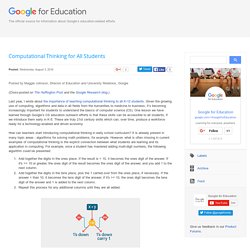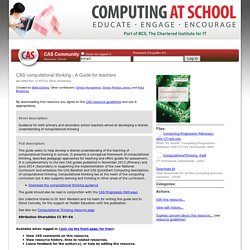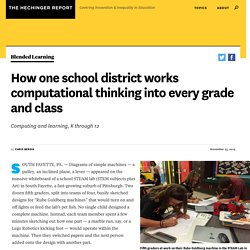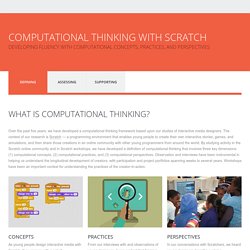

Computational Thinking for All Students. Posted by Maggie Johnson, Director of Education and University Relations, Google (Cross-posted on The Huffington Post and the Google Research blog.)

Last year, I wrote about the importance of teaching computational thinking to all K-12 students. Given the growing use of computing, algorithms and data in all fields from the humanities to medicine to business, it’s becoming increasingly important for students to understand the basics of computer science (CS). One lesson we have learned through Google’s CS education outreach efforts is that these skills can be accessible to all students, if we introduce them early in K-5. These are truly 21st century skills which can, over time, produce a workforce ready for a technology-enabled and driven economy. How can teachers start introducing computational thinking in early school curriculum? Add together the digits in the ones place. Computational thinking for all. A computational thinking guide & Progression Pathways assessment framework including computational thinking: KS1 (Y1) to KS3 (Y9)
CAS computational thinking - A Guide for teachers last edited Nov 12 2015 by Simon Humphreys Full description: This guide seeks to help develop a shared understanding of the teaching of computational thinking in schools.

It presents a conceptual framework of computational thinking, describes pedagogic approaches for teaching and offers guides for assessment. It is complementary to the two CAS guides published in November 2013 (Primary) and June 2014 (Secondary) in supporting the implementation of the new National Curriculum and embraces the CAS Barefoot and CAS QuickStart Computing descriptions of computational thinking. Computational thinking lies at the heart of the computing curriculum but it also supports learning and thinking in other areas of the curriculum. Download the computational thinking guidance The guide should also be read in conjunction with the CAS Progression Pathways See also our Computational Thinking resource page Attribution-ShareAlike CC BY-SA.
How one school district works computational thinking into every grade and class. SOUTH FAYETTE, PA. — Diagrams of simple machines — a pulley, an inclined plane, a lever — appeared on the massive whiteboard of a school STEAM lab (STEM subjects plus Art) in South Fayette, a fast-growing suburb of Pittsburgh.

Two dozen fifth graders, split into teams of four, busily sketched designs for “Rube Goldberg machines” that would turn on and off lights or feed the lab’s pet fish. No single child designed a complete machine. Instead, each team member spent a few minutes sketching out how one part — a marble run, say, or a Lego Robotics kicking foot — would operate within the machine. Then they switched papers and the next person added onto the design with another part. There are two other STEAM labs in this school for third, fourth and fifth graders, which South Fayette opened in 2013. Computational thinking is intimately related to computer coding, which every kid in South Fayette starts learning in first grade. “We started being invited into classrooms,” said Owens. Center for Computational Thinking, Carnegie Mellon. What is computational thinking?

"Computational Thinking is the thought processes involved in formulating problems and their solutions so that the solutions are represented in a form that can be effectively carried out by an information-processing agent. " Cuny, Snyder, Wing Computational thinking is a way of solving problems, designing systems, and understanding human behavior that draws on concepts fundamental to computer science. To flourish in today's world, computational thinking has to be a fundamental part of the way people think and understand the world. Wing06. Computational Thinking. In our conversations with Scratchers, we heard young designers describe evolving understandings of themselves, their relationships to others, and the technological world around them.

This was a surprising and fascinating dimension of participation with Scratch — a dimension not captured by our framing of concepts and practices. As the final step in articulating our computational thinking framework, we added the dimension of perspectives to describe the shifts in perspective that we observed in young people working with Scratch, which included three elements: expressing: realizing that computation is a medium of creation, "I can create.
" connecting: recognizing the power of creating with and for others, "I can do different things when I have access to others. " questioning: feeling empowered to ask questions about the world, "I can (use computation to) ask questions to make sense of (computational things in) the world. " CT Definitions. BarrStephensonInroadsArticle. 472.11CTTeacherResources 2ed SP vF. CompThinkingFlyer. Computational thinking and thinking about computing. WingCTPrez. Wing06 ct.